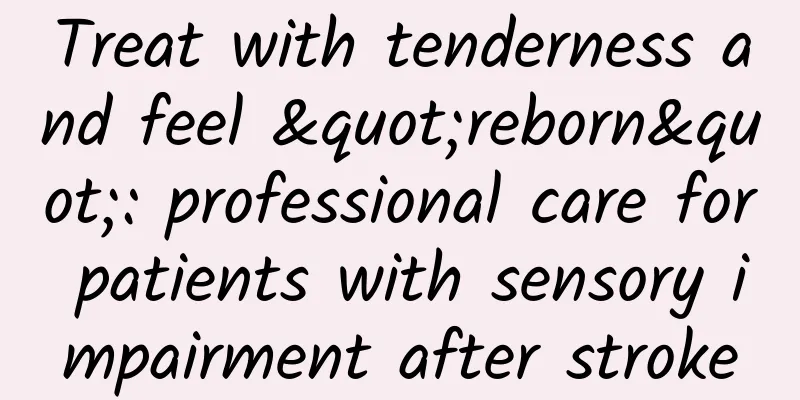Treat with tenderness and feel "reborn": professional care for patients with sensory impairment after stroke

|
Author: Liu Yali China Rehabilitation Research Center/Beijing Boai Hospital Reviewer: Zhang Xiaonian, Chief Physician, China Rehabilitation Research Center/Beijing Boai Hospital Stroke, as a sudden cerebrovascular disease, not only threatens the life safety of patients, but is also often accompanied by a series of sequelae. It not only has a great impact on the physical and mental health of patients, but also brings a heavy burden to families and society. Sensory impairment is one of the common complications after stroke. Sensory impairment covers touch, pain, temperature, position, vibration and other aspects. It makes patients face many inconveniences in daily life and even affects their emotions and mental health. Therefore, it is particularly important to provide professional and meticulous care for the sensory impairment of stroke patients. 1. Impact of sensory impairment Sensory impairment is a common sequela of stroke, mainly manifested as a weakened or lost ability of patients to respond to external stimuli, such as insensitivity to touch, weakened pain sensation, and inability to accurately perceive temperature or position. Sensory impairment not only affects patients' ability to take care of themselves in daily life, such as dressing, eating, washing, etc., but may also cause patients to become emotionally unstable, anxious, depressed, and even develop an inferiority complex. In addition, sensory impairment may also affect the effectiveness of patients' rehabilitation training, because correct perception is the basis for effective exercise. Therefore, it is particularly important to provide scientific and meticulous care for sensory impairment in stroke patients. 2. Professional nursing care for sensory impairment after stroke 1. Comprehensive assessment and personalized care plan After stroke patients are admitted to the hospital, nursing staff should first conduct a comprehensive sensory function assessment, including touch, pain, temperature, position and vibration. Based on the assessment results, a personalized care plan is developed for the patient to ensure the pertinence and effectiveness of the care measures. 2. Environment and body position management (1) Create a comfortable environment: Create a quiet, clean, temperature-appropriate (18-22°C), humidity-appropriate (50%-60%) rehabilitation environment for patients to reduce the impact of external stimuli on patients. Figure 1 Copyright image, no permission to reprint (2) Reasonable body position setting: For hemiplegic patients, the "good limb position" setting should be adopted, that is, the upper limb on the affected side is kept in an extended position and the lower limb is slightly flexed to relieve limb spasm and pain. At the same time, the body position should be changed regularly to prevent pressure sores and joint stiffness. 3. Physical therapy and rehabilitation training (1) Sensory facilitation training: Sensory facilitation training is one of the important means to improve sensory impairment after stroke. By stimulating the patient's damaged sensory area, it promotes neuronal regeneration and functional recovery. For example, using objects of different textures for tactile stimulation training; using warm or cold water for temperature stimulation training; using a vibrator for vibration stimulation training, etc. These trainings should be conducted under the guidance of professionals to ensure the safety and effectiveness of the training. (2) Exercise therapy: Exercise therapy not only helps restore the patient's limb function, but also indirectly promotes the recovery of sensory function. Through appropriate exercise training, such as standing, walking, and fine hand movements, the patient's muscle strength and joint flexibility can be enhanced, thereby improving their ability to perceive external stimuli. (3) Joint compression training: Compression of joints by external force can effectively promote joint tension and promote sensory recovery. The order of compression is from proximal to distal, that is, from shoulder to elbow to wrist joint, and from hip to knee to ankle for lower limbs. It provides better sensory input to the joints and can also reduce muscle tension. Figure 2 Copyright image, no permission to reprint (4) Psychological care and emotional support: Communicate with patients regularly, listen to their feelings, and help them relieve anxiety and depression. Encourage family members to actively participate in the patient's recovery process and provide emotional support. If necessary, seek the help of a psychological counselor to provide professional psychological intervention for the patient. Figure 3 Copyright image, no permission to reprint 4. Daily living skills training (1) Dressing training: Instruct patients on how to dress and undress correctly, especially the clothing on the affected limb. During the training process, attention should be paid to detailed guidance, such as how to grasp clothing with fingers and how to adjust the position of clothing. At the same time, you can touch the different fabrics of clothes before changing, which can effectively improve your ability to recognize materials. (2) Eating training: Instruct patients on the correct eating methods and essentials. For patients with temperature perception problems, instruct them to touch the surface of objects before eating or drinking to sense the temperature of the objects. Repeated stimulation has a certain improvement effect on patients with temperature perception disorders. For patients with dysphagia or chewing weakness, easy-to-swallow food, such as mushy food, soft food, etc., should be provided. At the same time, instruct patients on how to chew and swallow food correctly to avoid aspiration and suffocation. (3) Washing and gargling training: Instruct patients on how to properly use toothbrushes, toothpaste and other tools for oral cleaning, how to wash their faces and hands, etc. During the training process, attention should be paid to the accuracy and coordination of the movements. You can also use a brush or a thorn ball to stimulate the patient's skin to promote blood circulation in the limbs and achieve the process of sensory recovery. 5. Rehabilitation training and monitoring (1) Professional guidance: Rehabilitation training should be carried out under the guidance of a rehabilitation physician or therapist. The training content should be formulated according to the specific situation of the patient, including muscle strength training, balance training, coordination training, etc. (2) Regular monitoring: Regularly monitor the patient's neurological function recovery, including the degree of improvement of sensory impairment, muscle strength recovery, balance and coordination ability, etc. At the same time, pay attention to whether the patient has new symptoms or complications so as to adjust the treatment plan in time. 6. Health education (1) Knowledge popularization: Popularize relevant knowledge about stroke and its complications to patients and their families to improve their cognitive level. (2) Rehabilitation plan: Develop a personalized rehabilitation plan and regularly evaluate the patient's rehabilitation progress. 3. Prevention and relapse management Prevention of stroke is as important as recurrence management. The risk of stroke can be reduced by improving lifestyle and controlling risk factors. Specific measures include the following. 1. Quit smoking and limit alcohol consumption Smoking and excessive drinking are risk factors for stroke. Therefore, patients should quit smoking and limit alcohol consumption as soon as possible to reduce the risk of stroke. 2. A reasonable diet: Maintaining a low-fat, low-sugar, high-protein, high-vitamin diet can help prevent stroke. At the same time, the intake of dietary fiber should be appropriately increased to promote intestinal peristalsis and prevent constipation. Figure 4 Copyright image, no permission to reprint 3. Appropriate exercise Appropriate exercise can enhance physical fitness, improve immunity, lower blood pressure and blood lipid levels, and thus prevent the occurrence of stroke. Patients are advised to choose appropriate exercise methods such as walking, jogging, Tai Chi, etc. according to their own conditions. 4. Regular physical examinations Regular physical examinations can timely detect and control risk factors for stroke such as hypertension and diabetes, thereby reducing the risk of disease. IV. Case Sharing The patient, Mr. Liu, 60 years old, suffered from a sudden stroke, which led to poor right limb movement and sensory impairment. After admission, after a comprehensive evaluation and diagnosis, the nursing team developed a personalized rehabilitation care plan for him. Under the guidance of the physical therapist, Mr. Liu received systematic rehabilitation training. At the same time, the nursing staff also paid close attention to the changes in his mental state and provided psychological counseling and emotional support in a timely manner. After several months of hard work, Mr. Liu's sensory function has been significantly improved. He can perceive external stimuli again and gradually recover some of his daily life ability. V. Conclusion Nursing for sensory impairment in stroke patients is a complex and meticulous process that requires the joint efforts of medical staff, patients and their families. Scientific and systematic nursing measures can effectively improve patients' sensory impairment, improve their quality of life, and reduce the burden on their families and society. At the same time, we should also realize that preventing stroke is equally important. The risk of stroke can be reduced by improving lifestyles and controlling risk factors. For patients and their families, it is crucial to understand the characteristics of sensory impairment and its nursing points. I hope this article can provide valuable references for stroke patients and their families to help them better face this challenge. |
<<: Prevention and treatment of diabetic retinopathy
Recommend
Why does the vulva crack repeatedly?
The vulva is a part of the female lower body. It ...
Causes of lower abdominal pain in women
Lower abdominal pain in women is generally caused...
Pregnant women infected with Helicobacter pylori
Pregnant women are not allowed to take medicine i...
National Disability Prevention Day | Everyone needs to know about disability!
When we talk about disability, we often think of ...
Is bleeding 2 days after sex a sign of implantation?
Generally, if sexual intercourse occurs during a ...
How long is the best time for medical abortion
Before having a medical abortion, women must unde...
What is total human chorionic gonadotropin
The question I want to talk to you about today is...
What to do if liver function is abnormal during pregnancy
After becoming pregnant, women will go to the hos...
Will a herpes zoster outbreak kill you? One method is the most effective in preventing it!
gossip "Snakehead herpes and entanglement wi...
Causes and treatment of prolonged menstruation
Menstruation is a physiological phenomenon that e...
Tips for toe pain from wearing high heels
Many female friends prefer to wear high heels in ...
The best age for treatment of stone women
Many people are curious about stone women, a type...
What does positive leucorrhea clue cells mean?
Discharge is a substance that all normal pregnant...
What should I eat if my period is too light?
Women's menstruation is an indispensable phys...
Treatment for 50 days of pregnancy without embryo bud
We all know that the incidence of diseases is inc...









